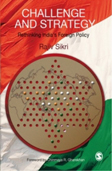 A review essay by Teresita C. Schaffer of four books about Indian foreign policy: Challenge and Strategy: Rethinking India’s Foreign Policy, by Rajiv Sikri; India’s Foreign Policy: The Democracy Dimension, by S.D. Muni; The Long View from Delhi: To Define the Indian Grand Strategy for Foreign Policy, by Raja Menon and Rajiv Kumar; and In the National Interest: A Strategic Foreign Policy for India, by Rajiv Kumar and Santosh Kumar.
A review essay by Teresita C. Schaffer of four books about Indian foreign policy: Challenge and Strategy: Rethinking India’s Foreign Policy, by Rajiv Sikri; India’s Foreign Policy: The Democracy Dimension, by S.D. Muni; The Long View from Delhi: To Define the Indian Grand Strategy for Foreign Policy, by Raja Menon and Rajiv Kumar; and In the National Interest: A Strategic Foreign Policy for India, by Rajiv Kumar and Santosh Kumar.
A few elements are common to all these snapshots of India’s foreign policy. The first is India’s desire to dominate its immediate neighbourhood. How it interprets the requirement for continued primacy has changed, seen most notable in the conclusion that a regular American presence in the Indian Ocean serves India’s interests (a conclusion Sikri might question). But whether or not an author places the troubled relationship with Pakistan at the top of India’s foreign-policy challenges, in all four studies, India’s determination to retain great-power status in South Asia is not open to serious question.
Originally published by the International Institute for Strategic Studies in the December 2010-January 2011 issue of Survival. Read the entire essay.

